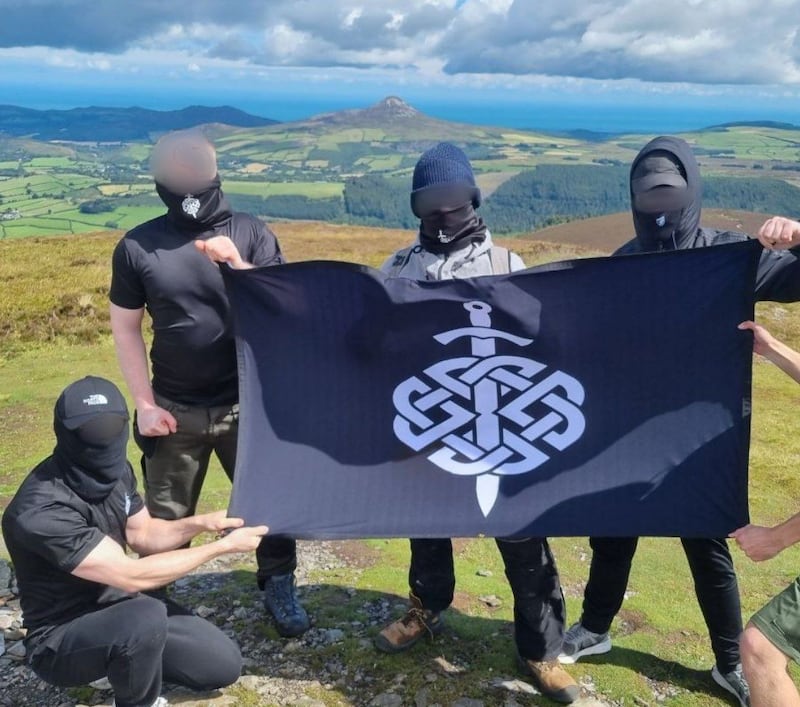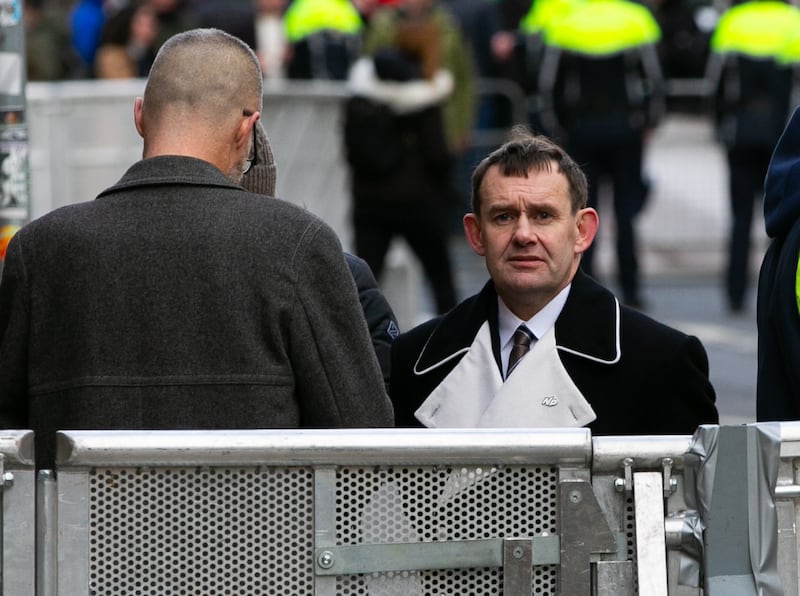Last month, a group of right-wing extremists, from Ireland, the US and continental Europe gathered online for a three-hour discussion on how to stop immigration into Ireland, by force or otherwise.
These virtual meetings have become an almost daily ritual for the disparate group. Sometimes the meetings attract dozens of attendees but the conversation is usually dominated by a handful of voices.
One of those voices belongs to the organiser of the meetings, a Tipperary man aged in his late 20s. During the meet on June 18th, he had a dark warning for the others.
“It’s going to be a power struggle,” he said. “We’re just going to have to break them down. We’re quickly running out of time.”
READ MORE
The conversation turned to a familiar topic, the justification of using violence to stop immigration. The Tipperary man made his views clear: “We need some acceleration. They’re messing with forces they don’t even understand.”
One of the Americans remembered an article he read about people burying pigs on a site in Europe to stop a mosque being built there. Maybe something similar would work for asylum seeker sites in Ireland, he wondered.
The Tipperary man became excited. “It’s a great idea,” he said before suggesting putting pigs’ blood in water guns and “squirting it into their faces”.
The following week, two pigs were found at Thornton Hall, a site in Dublin earmarked as accommodation for hundreds of asylum seekers. The pigs had been stabbed but were still alive, and later had to be put down.
They don’t have much of an ideology to speak of, except that they hate foreigners and want to do them harm
The Tipperary man, who says he identifies as a “bit of a national socialist”, has been involved in protests outside accommodation centres.
No evidence has emerged to link him to the Thornton Hall incident. However, his rhetoric is part of a growing trend among Irish far-right extremists who eschew electoral politics and are engaged in loud calls for physical confrontation or violence.
The Tipperary man, and others like him, can be remarkably frank about their intentions. “I don’t know how many virgins are going to be waiting, but I’ll happily help them get there if they want,” he said in the publicly accessible meeting, in reference to Muslim immigrants.
There are limits, however. During another meeting, he admonishes other attendees for openly talking about the use of guns in an open forum. “Surely you’re not that thick?”
Another newly-established group which focuses on physical confrontation is Comhaltas na nGaedheal (CnG). Established at some point last year, the group is part of a growing international network of so-called “active clubs”.
Founded by Robert Rundo, a violent neo-Nazi from the United States, the Active Club network has cells across American and Europe. Rundo, who is currently in US custody on federal conspiracy and rioting charges, intended these active clubs to be a network of decentralised cells, meaning they will persevere even if the leadership is arrested.
The movement, sometimes dubbed White Nationalism 3.0, evolved directly from Rundo’s previous organisation, the Rise Above Movement, which has been described as a sort of neo-Nazi “fight club”.
Like its predecessor, the Active Club movement mixes extreme right-wing positions with a focus on masculinity and physical fitness, particularly mixed martial arts. Evidence of this can been seen in the social media postings of CnG.
The group frequently posts photographs of its members engaged in combat sports training. Great care is taken to blur faces and other identifying marks. In some cases, participants’ footwear is even blurred to conceal their identities.
Members of the group have shown up at several anti-immigrant protests, including in Coolock last March. However, they hold a deep contempt for many of their fellow anti-immigration activists, such as Gavin Pepper and Hermann Kelly, whom they consider moderates.

CnG does not just want a dramatic reduction in immigration, it wants mass deportations, according to an associate of the group who spoke with The Irish Times.
“Are you going to roll over and die, Gaelic man?” it says in one post appealing for members. “Nationalism is only as credible as the men who speak about it. If you can’t fight, learn,” another reads. In a another post, a member compares CnG to the IRA of the 1920s and the Troubles.
It has close links with other active clubs in the US and Europe. Last year, members of Junge Tat, a club from German-speaking Switzerland, visited CnG members and attended an anti-immigration protest in East Wall.
Members of Active Club Scotland have also visited the group on at least one occasion.
“Through its online posts that feature content championing the white race and demeaning multiculturalism and its offline activities that include hiking, training and combat/MMA work, it’s clear Comhaltas na nGaedheal views itself as following in the active club tradition,” says Ciaran O’Connor, a senior analyst at the Institute for Strategic Dialogue, a counter-extremism organisation.
The goal of active clubs is to appeal to disillusioned young men who spend too much time online and have few social activities. “You need to get off the internet. You need to hike, lift weights and train,” CnG told prospective members shortly after its establishment.
In terms of violence, in self-defence terms, it’s whatever is necessary. But we’re certainly not going to be relying on the police
This appeal to angry keyboard warriors has yielded startling results worldwide. Extremism researchers have been taken aback by the growth of the active club movement. According to a recent report from the Counter Extremism Project, since its establishment in 2021, the network has grown to 104 known cells worldwide.
Until recently, the Irish cell had strong connections to Justin Barrett, the disputed leader of the far-right National Party. According to sources, Barrett sought to use the CnG as a uniformed protection squad for the National Party.
These plans did not sit well with other National Party leaders, who saw growing concerns about immigration as an opportunity to appeal to mainstream voters. Uniformed protection squads were unlikely to help the party shed its extremist image. Barrett was forced out, although he still claims to be leader of the National Party, and his association with CnG came to an end.
Instead, he turned his focus to establishing another group, called Clann Éireann. “Retreat has failed! Democracy has failed! No more will we negotiate our existence with our intractable enemies, nor accept the rules they use to bind us,” Barrett posted on the new group’s website last year, while stressing Clann Éireann was “in no way a political party”.

At the same time, the Clann Éireann members began plastering lamp-posts across Dublin with stickers depicting a masked paramilitary and Clann Éireann’s swastika-like logo, while Barrett took to openly praising Hitler and wearing military-style uniforms.
Barrett did not respond to requests for comment, but he expanded on his new group last month in a recent interview with the podcast of the Nordic Resistance Movement (NRM), a large Swedish neo-Nazi organisation which has carried out violent attacks against politicians and journalists.
The US State Department recently designated the NRM a terrorist organisation, citing its efforts to acquire weapons and explosives and its involvement in training in hand-to-hand combat.
Barrett told his interviewer that Clann Éireann is intended to be an “ideological vanguard” to spread “social and national ideas”. It will include an “uniformed security wing” called Sciath Náisiúnta to protect its members “from violent assault by the reds”, he said.
Nationalism is only as credible as the men who speak about it. If you can’t fight, learn
“In terms of violence, in self-defence terms, it’s whatever is necessary. But we’re certainly not going to be relying on the police.”
Gardaí responsible for monitoring extremist activity are aware of both CnG and Clann Éireann. However, they are of the view that they currently pose little threat and that their membership remains small.
Barrett’s organisation comprises fewer than 20 members, including his wife, according to one source.
Of far greater concern for authorities are the less organised groups who have been increasingly targeting immigrants with violence in recent months. “These are people who are not a member of a party or group but might share information and plans. They don’t have much of an ideology to speak of, except that they hate foreigners and want to do them harm,” said a security source.
In particular, gardaí are concerned about the growing number of violent attacks on asylum seekers which are being filmed and uploaded to social media, before being shared in the far-right online ecosystem.
Almost a dozen such videos have gone viral in recent months. In most cases, the footage was accompanied by claims that the assault victim had been caught engaging in a crime of some sort, usually involving a perceived threat to children. “In most if not all cases, there was absolutely nothing to support that they were a threat to anyone, including children,” said a senior garda.
Great care is taken to blur faces and other identifying marks. In some cases, participants’ footwear is even blurred to conceal their identities
The severe shortage of accommodation for asylum seekers has also created a new danger. Makeshift camps set up by homeless asylum seekers have become a frequent target of attacks or intimidation.
On Tuesday, as gardaí attempted to quell anti-immigration violence in Coolock, a group of asylum seekers who had set up tents in Phibsborough were targeted by masked men, including one brandishing a hurley.
Gardaí moved the aggressors on, and the asylum seekers were relocated to various other locations. By Wednesday, some had set up camp on City Quay in the city centre.
That night, a group of men armed with knives and iron bars attacked the camp. The tents were slashed and thrown into the water and their occupants were forced to flee to Pearse Street Garda station for safety.
Gardaí say they are investigating the matter as a case of criminal damage. No arrests have been made.
- Sign up for push alerts and have the best news, analysis and comment delivered directly to your phone
- Find The Irish Times on WhatsApp and stay up to date
- Our In The News podcast is now published daily – Find the latest episode here


















